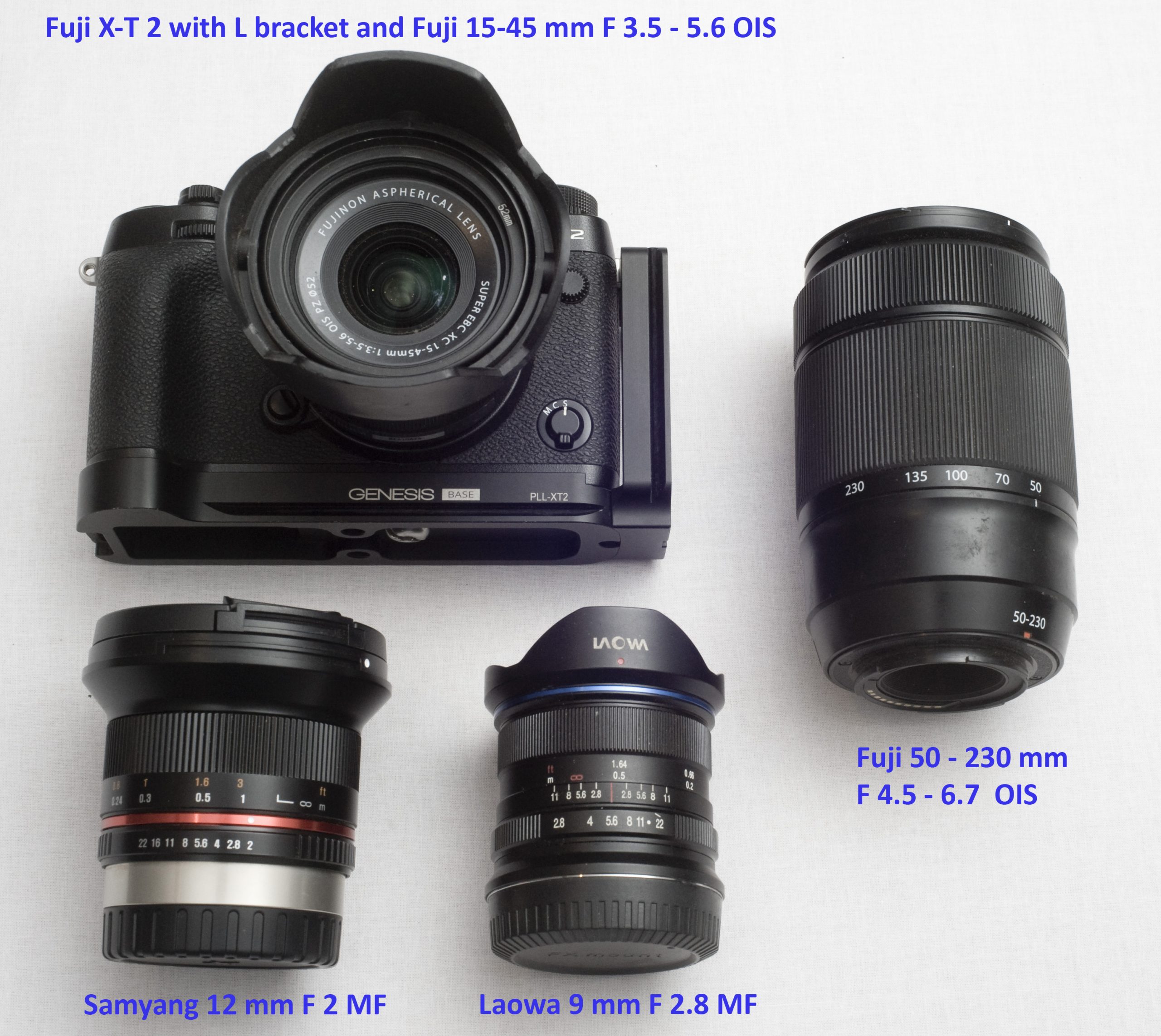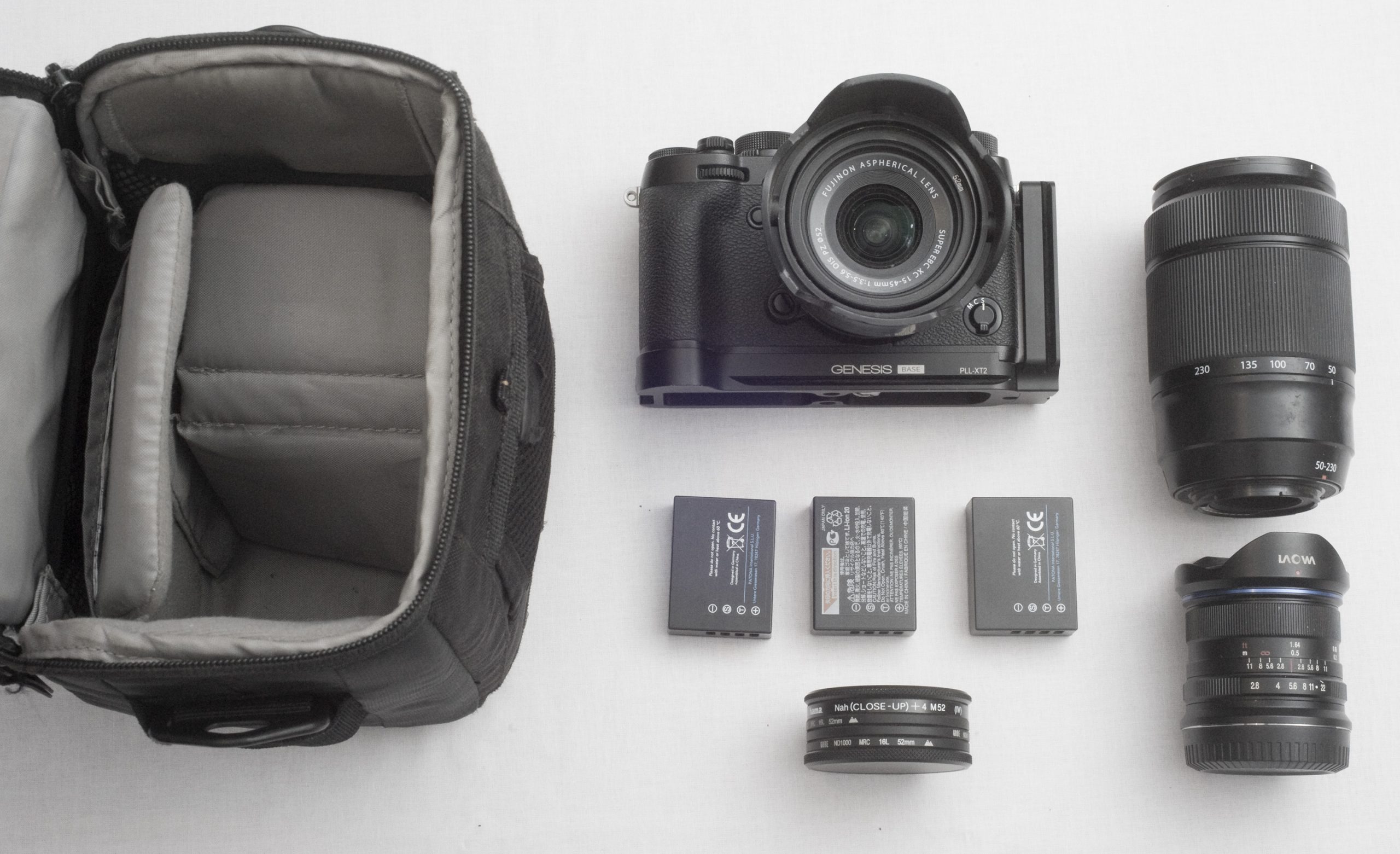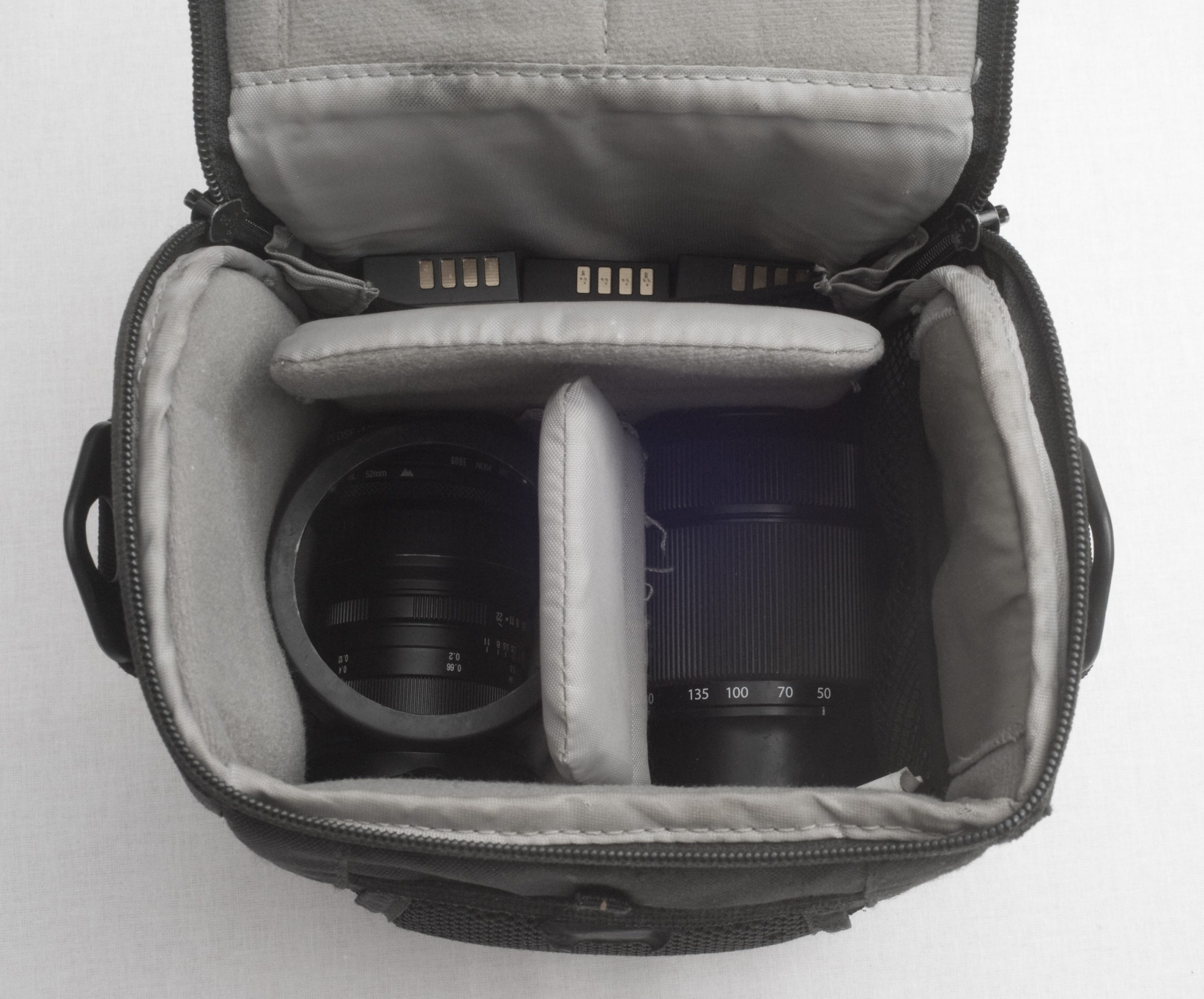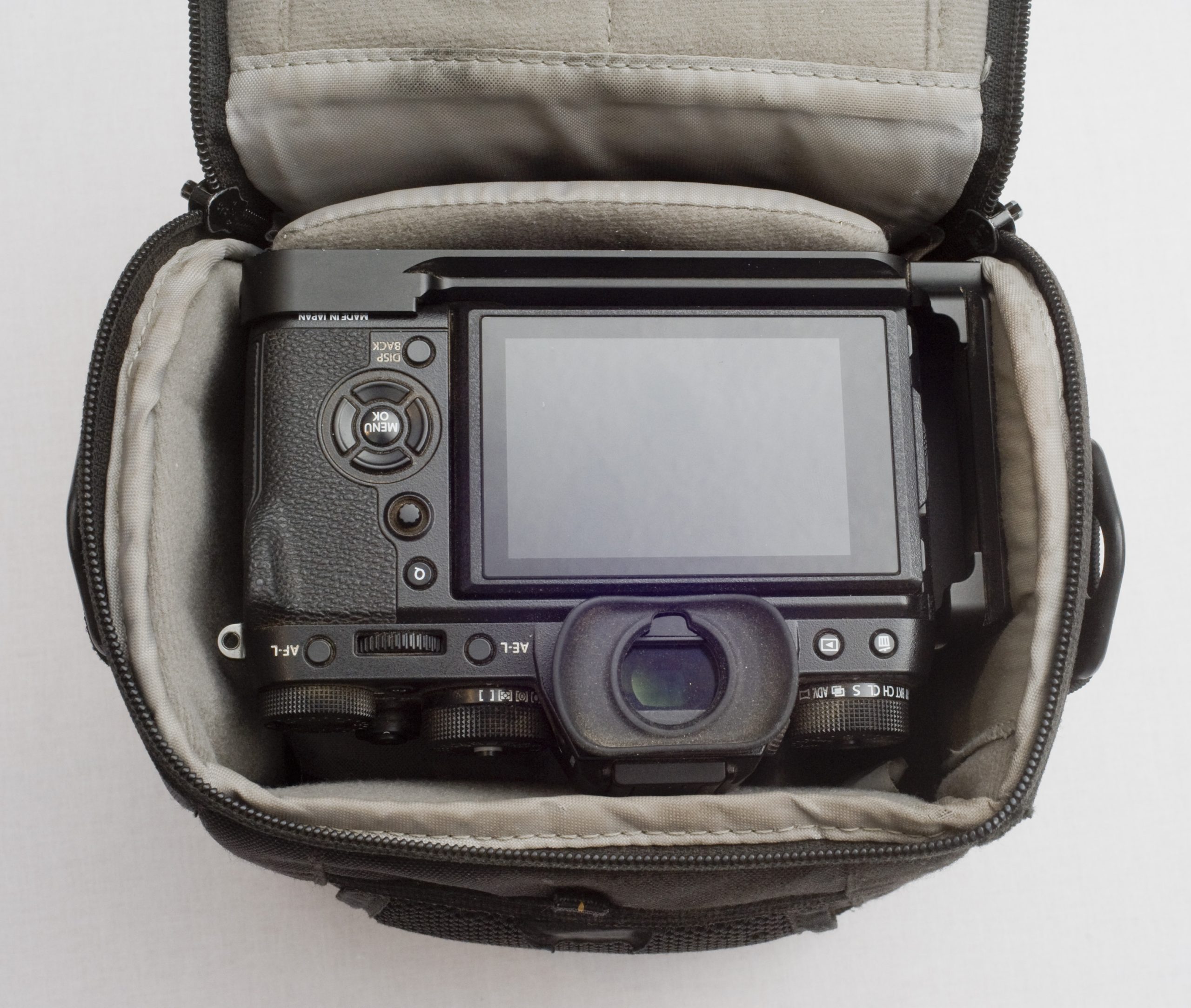I like photography, with a focus on its technical aspects. My landscape and nature photo experience is quite limited, nevertheless.
Since a long time I own a Nikon DSLR system with a good selection of lenses. But for this trip it would be too bulky and heavy, so I decided to go for another camera system. I did not want to sacrifice too much light sensitivity; an APS-C sensor size seems a good compromise between system (= lens) weight and dynamic range / noise properties. Please do not just compare the weight of the camera body but also consider the lenses you want to carry.
For some time I had the idea to stay just with a 1” sensor compact camera Sony RX 100 or a crippled mFT sensor compact model Panasonic LX100 instead, like many people use on trail, which would save a lot of weight, but this would not allow night landscape photos with the starry sky in good quality, and very wide angles only as panos.
Because I want to use fast wide angle lenses a mirrorless camera system with its shorter flange distance and therefore smaller lens diameters has advantages over a DSLR, weight-wise. In early 2019 there were three APS-C DSLM systems on the market:
-
- Canon EF-M mount
- Fujifilm X mount
- Sony E mount
Canon’s sensors are inferior to Sony’s used in the two other brands because of less low-ISO dynamic range; therefore Canon was out and the race was only between Fuji and Sony. I tested a Fuji X-T 100 with a 15-45 mm lens against a Sony A6300 with a 16-50 mm lens. Both lenses are cheap kit lenses sold with the camera, but such are the most lightweight ones. The test showed that the Sony 16-50 has an awful quality around 16 mm at the frame edges; it was the crappiest lens I had ever used. And there is no lightweight alternative starting <18 mm for E mount. So Sony was out, too, though I liked the A6300 body because of its rangefinder style.
The Fuji 15-45 has a remarkable good quality around 15 mm with some degradation versus longer focal length. But the X-T 100 body is an ergonomic nightmare for me. I had choosen it for its low price tag and its Bayer patterned sensor. After long considerations I exchanged it against a used Fuji X-T 2 body, and now was nearly perfectly happy with the ergonomics. The price I had to pay was about 100 g more weight and the special Fuji X-TRANS colour filter pattern on the sensor which is not well compatible with most image processing programs, and has even more cons than pros for image quality, though Fuji seems successfully indoctrinate their fan-boys about its uniqueness.
Now the system decision was made in favour of Fujifilm. For milkyway photos and timelapses a manual focus 12 mm F/2 Samyang lens is the best compromise between weight and image quality, with acceptable coma and astigmatism in the edges. In addition I bought the most lightweight Fuji telezoom, a 50-230 mm, for wildlife and landscape details, and finally found a manual focus 9 mm Laowa ultra wide angle at a decent price. This has a strong vignette even when stopped down to F/8, but at 220 g for such an ultra-wide angle some compromise cannot be avoided.
Then my lens setup was complete:
On trail I used these lenses as I had expected: the vast majority of the photos was shot with the 15-45 which has a nice focal range for landscape (like 23-67 mm in a 35 mm “full frame” system). Both the tele and the ultra wide angle have their special application, for no more than 10% of all photos, but including some important ones. Shooting the 26 photos selected for the front page of this site I had used:
-
- 18 times the 15-45 mm
- 5 times the 9 mm
- twice the 50-230 mm
- once the 12 mm
I also had a filter set for the 15-45 consisting of three ND filters (8x, 64x and 1000x) and a +4 dpt close-up lens. I used the 64x ND filter twice for a handheld shot of flowing water, extending the exposure time to 1/8 s, which shows the water more dynamical and not just frozen. You cannot apply this method when there is some wind, and the grass and plants move too, and one needs some stabilization in the lens or body for handheld use. – Those silk-like pictures of moving water one often can see – a bit too often, I feel – would need the 1000x and a tripod, with a multi-second exposure.
The 12 mm F/2 Samyang was carried in my backpack together with the tripod and retrieved only at the tent sites for night sky photography. But the rest of the gear should be easily accessible during the hike. So I needed a photo bag.
I own several LowePro bags of various sizes, but none fitting here. After some research I figured out that the LowePro Apex 120 AW should be just big enough, and found a used one on eBay. The gear fits in, the tele lens only without front and back cover but it is well protected by the heavy cushion of the bag. “AW” means “all weather”: it has a built in rain cover which has to be put over the bag for protection in case of heavier rain. I had to use this only once on trail.
I then experimented how to fix this bag to the backpack. The hip belt would be the logical choice, but this photo bag is already too big and quite heavy, and would hamper my leg’s movement on the hike. After quite some trials I found a way where to fix two straps on the pack – one on its external frame, the other on the shoulder belt – such that the photo bag hangs a bit higher in front of the hip belt, on the right side, and the straps do not chafe my body. I made this harness adjustable so that I always can find the best position under varying conditions.
I added a snap hook to each strap and thus could snap in the bag using its original eyelets, normally intended for the shoulder strap. To take down the backpack I first have to open the left hook and can then carefully put the pack to the ground, with the photo bag still hanging on the right strap. This fixture worked very well, it even helped to remove some load/pressure from the front side of my shoulders by counterbalancing the backpack.
The tripod I carried is very lightweight but also petite. It consists of the tripod itself, a FLM CP10 with non-extensible but widely adjustable carbon fibre legs, and a Novoflex 19P ball-head with panorama function. Both are genuine German products. Other than the popular cheap JOBY GorillaPods it provides a solid stand even with heavier loads, without any droop, e. g. for timelapses. I have also added a velcro strap to be able to fix it to a post or tree but had never used this.
In addition there was a L bracket on the X-T 2 and a matching Arca Swiss compatible clamp on the tripod – very comfortable but added 150 g so I probably would leave those at home next time.
I used a separate USB charger for my camera batteries though the X-T 2 can charge via USB itself, but only when not operating. Fed from the powerbank only one bay should be used at a time but I had this two-bay model at hand.
These are the items that went into the backpack – the Samyang lens in a DCF bag somewhere down between the sleep system, the Patona USB charger together with the other electronic stuff, and the tripod on top for easy access in case I would need it. I could have put it in the outside mesh pocket, too, but this was already stuffed with other items, and I did not want to risk to loose it as it is quite expensive.
The weight of the photo gear carried in the front bag:
-
- the bag itself, without its harness: 280 g
- Fuji X-T2 body only: 455 g
- L bracket: 105 g
- Fuji 15-45 mm lens with hood: 160 g
- Fuji 50-230 mm lens: 390 g
- Laowa 9 mm lens with hood and 2 covers: 220 g
- filter set: 70 g
- 4 batteries: 200 g
- 5 SD cards: 10 g
So I carried a total of 1890 g of photo gear outside the pack. In addition:
-
- tripod + head: 240 g
- QC clamp: 50 g
- battery charger: 55 g
- Samyang 12 mm lens with bag: 300 g
which makes another 645 g and sums up to a total of more than 2.5 kg.







